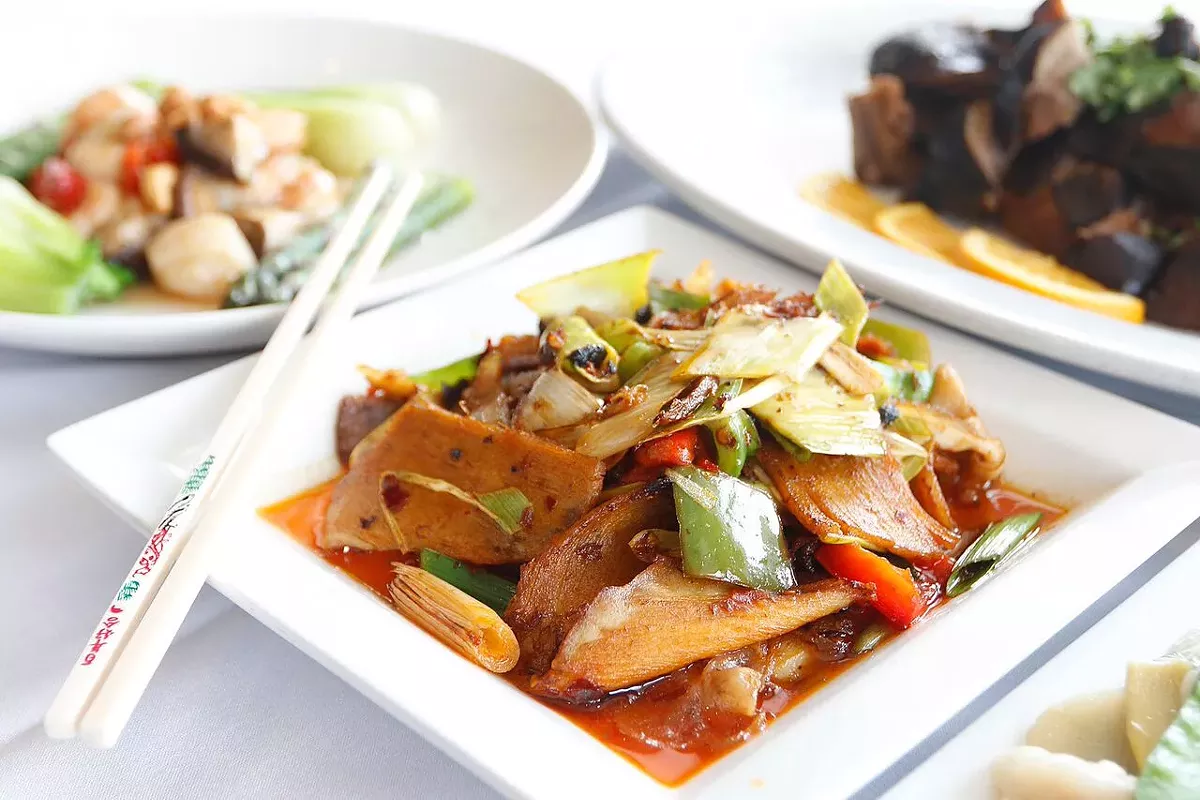An alert reader and self-taught expert on Chinese cooking wrote to me about Taste of China: "They have many items not found elsewhere and not all for the faint of heart." Even the non-faint might blanch at Stewed Beef Stomach, Spiced Tendon, Pork Intestine with Pork Blood Cake, or Pork Intestine with Special Cooking.
But they would be rewarded by ordering from Taste of China's long (255 items) Chinese menu. If you can't decipher the menu, you'll have to ask to get the bilingual Chinese menu, as there's a separate one catering to the Western customer.
Brief refresher: Most Americans are familiar with meiguorende kouwei — Chinese food cooked "to American taste." Almond chicken, sweet and sour whatever, chow mein at the bottom of the scale. Zhongguorende kouwei, food cooked to "Chinese taste," is far more varied, encompassing Chinese cuisines such as Hunan, Sichuan, Guangdong, Shandong, and more, with 5,000 named dishes. One writer tried, inadequately, to sum it up as "flavors vary from the delicate to the electric."
Since spending a semester in China in 2007, I've been seeking and re-seeking the electric. Taste of China's Lamb with Cumin (205) delivered: hot red pepper flakes made the cumin pop against the pungency of the tender lamb. Size mattered too — this was an enormous serving. Lamb with Cumin is the type of dish you go to an authentic Chinese restaurant for.
Twice-Cooked Pork (Fat) (175) was wide strips of pork belly with red and green peppers in a sauce of gold, dotted with fermented black beans. This one was almost equally intense, but mellower because of the silky fat.
As was Beef with XO Sauce (146), which uses snow peas. XO sauce is a 1980s invention from Hong Kong, made with dried scallops, fish, and shrimp. It may sound odd to pair it with beef, but it's widely used in all sorts of Hong Kong and Guangdong (Cantonese) meat or vegetable dishes.
If you're really into the sauces, you could be disappointed with Szechuan Smoked Tea Duck, which just offers hoisin sauce on the side. But the bird is meaty and rich, moist without greasiness. (Ever notice how other cultures cut up their birds along different lines than we do? Mexicans and Chinese seem to rely more on a sharp cleaver than on the natural joints.)
I liked two gingery dishes from the seafood section: Stir-Fried Shrimp (98) with carrots and snow peas, and Nine-Story Fish Fillet (83). The latter was not served in nine layers; owner Wai Chong Tam says "nine stories" refers to the anise-y Thai basil that's a main component of the dish, along with slippery-slidey wood-ear mushrooms (I had hoped there were nine tales behind the recipe). I'm a big fan of Chinese-style steamed-fish cookery, which seems to concentrate the flavors, but if you're used to a crisp crust, you may be discomfited.
A mild dish that might have shone in other contexts, but paled beside the cumin lamb and the pork belly, was Scallop and Shrimp with Vegetable (249), typical of coastal Fujian province with its use of seafood and mushrooms.
We tried one entree from the American-Chinese menu, and it was intense, sharp, and excellent: pine nut chicken, with wood ears and snow peas in a ginger-garlic sauce. That menu is mostly familiar dishes, and if the chicken is an indicator, they are better than in most restaurants that cater to Americans. Both egg rolls and spring rolls were also well done, light and crisp. They were actually better than Chive Flowers Cake (42), from the appetizer section of the Chinese menu, which was pretty plain. More interesting appetizers might have been Szechuan Pig Ear, Cold Jelly Fish, or Szechuan Sauerkraut. Or not.
Taste of China has been in business since 2013; before that, Tam used to run the highly regarded Middle Kingdom in Ann Arbor. He says he serves dishes from all over the country and Chinese residents and visitors from throughout the area come to him; I saw big parties seated at the round tables that are the Chinese norm. Tam also bragged of a certain senator who hosted a dinner there for Chinese investors.
Did they order Stewed Frog with Whole Garlic or Spicy Frog (Dry with Bone)? The latter is No. 88, a lucky number auspicious for investors. Was it winter, prompting an order of Hot Pot of Fried Chicken and Egg Plant with Spicy Sauce? Did they go all symbolic with Eight Precious Ingredients Chow Fun? Perhaps they ordered one of the 41 dishes that aren't translated into English.








